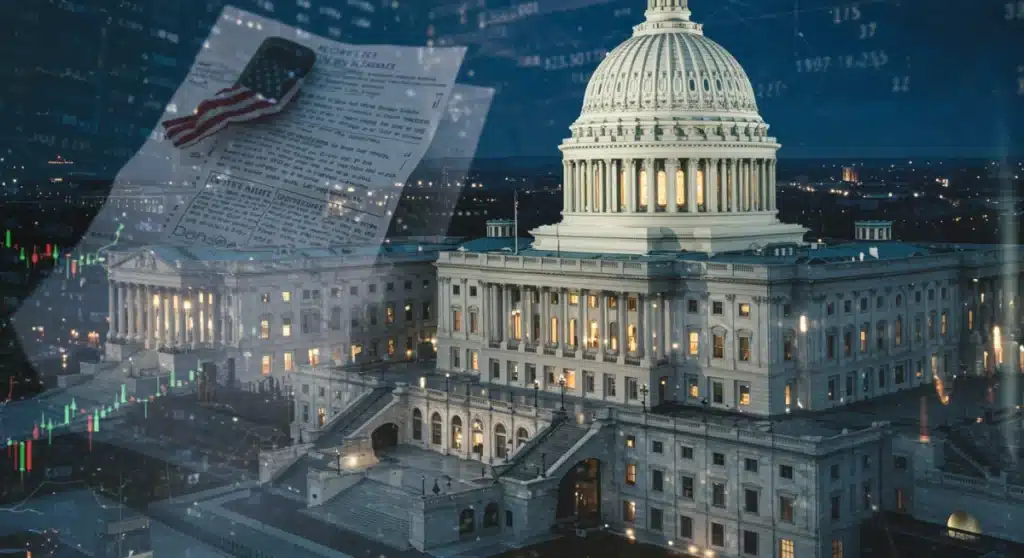US Politics: Legislative Trends Shaping Economy

The Future of US Politics: 3 Key Legislative Trends Shaping the Economy in the Next 18 Months is currently a central focus for businesses and citizens alike. Recent developments indicate significant shifts are underway, poised to redefine economic landscapes across the nation.
Infrastructure Spending and Job Creation
The Biden administration continues to push for substantial investments in national infrastructure, aiming to modernize critical systems and stimulate widespread job creation. This legislative trend, building on the Bipartisan Infrastructure Law, is expected to channel billions into sectors ranging from transportation to broadband over the next 18 months. The immediate goal is to enhance economic productivity and global competitiveness.
As of late, new proposals are emerging from various congressional committees, focusing on accelerating project timelines and ensuring equitable distribution of funds. These efforts are designed to mitigate inflationary pressures while maximizing the employment benefits across diverse communities.
Key Investment Areas
Current legislative discussions highlight specific areas targeted for significant capital infusion. These investments are projected to have a ripple effect, boosting local economies and fostering long-term growth.
- Transportation Networks: Upgrades to roads, bridges, public transit, and airports are receiving major allocations, aiming to improve logistics and reduce commute times.
- Broadband Expansion: Efforts to ensure high-speed internet access for all Americans, particularly in rural and underserved areas, are a top priority, seen as essential for modern economic participation.
- Clean Energy Projects: Funding for renewable energy infrastructure, including grid modernization and electric vehicle charging stations, is critical for both environmental goals and energy independence.
The ongoing legislative process involves intense negotiations to finalize appropriations and streamline regulatory approvals. According to recent reports from the Congressional Budget Office, these investments could add hundreds of thousands of jobs annually, primarily in construction, manufacturing, and related service industries. This sustained investment trajectory is considered a cornerstone of the administration’s economic strategy.
Technological Innovation and Regulation
The rapid pace of technological advancement is prompting lawmakers to consider new regulatory frameworks and incentivize innovation. Over the next 18 months, legislation concerning artificial intelligence (AI), data privacy, and semiconductor manufacturing is anticipated to significantly impact the tech sector and the broader economy. The objective is to balance economic growth with ethical considerations and national security.
Recent congressional hearings have underscored the urgency for comprehensive AI regulation, with a focus on accountability and transparency. Simultaneously, bipartisan efforts are underway to bolster domestic semiconductor production, reducing reliance on foreign supply chains and strengthening the US position in critical technology.
Data Privacy Debates
Discussions around a federal data privacy standard are gaining momentum, aiming to provide consumers with greater control over their personal information while offering businesses clear guidelines. This legislative push is a direct response to increasing public concern and the varying state-level regulations that create a complex compliance landscape for companies.
The proposed legislation seeks to harmonize existing regulations and establish a unified approach to data protection. This could involve stringent requirements for data collection, storage, and usage, potentially reshaping how technology companies operate and interact with their users.
Semiconductor Manufacturing Initiatives
The CHIPS and Science Act, enacted to boost domestic semiconductor research, development, and production, continues to see new legislative proposals aimed at its effective implementation and expansion. These supplementary measures are designed to ensure the US remains competitive in this vital industry, critical for everything from consumer electronics to defense systems.
The legislative focus includes allocating additional funding, establishing new research partnerships, and providing incentives for workforce development in semiconductor manufacturing. This proactive stance is intended to safeguard national economic security and foster a resilient supply chain for advanced technologies.

Healthcare Reform and Market Dynamics
Healthcare remains a perennial focus in US politics, with ongoing legislative efforts to address affordability, access, and market dynamics. Over the next 18 months, expect further debates and potential legislative actions concerning prescription drug pricing, health insurance coverage, and the future of the Affordable Care Act (ACA). These trends will directly influence healthcare providers, pharmaceutical companies, and consumers.
The current political climate suggests a continued push for measures aimed at lowering out-of-pocket costs for patients, particularly for essential medications. Lawmakers are exploring various avenues, including direct negotiation for drug prices and expanding subsidies for health insurance premiums, to alleviate financial burdens on American families.
Prescription Drug Pricing
One of the most contentious areas involves legislative proposals to reform prescription drug pricing. Building on provisions from the Inflation Reduction Act, which allows Medicare to negotiate prices for certain high-cost drugs, there are calls for expanding this authority and implementing additional mechanisms to control costs across the board. These discussions are closely watched by pharmaceutical giants and patient advocacy groups.
Potential legislative actions include imposing caps on out-of-pocket spending for prescription drugs, increasing transparency in drug pricing, and encouraging generic drug competition. The aim is to make innovative treatments more accessible without stifling pharmaceutical research and development.
Health Insurance Coverage
Efforts to strengthen and expand health insurance coverage are also a significant legislative trend. While the ACA remains a central pillar, lawmakers are considering policies to enhance its provisions, such as increasing federal subsidies for marketplace plans and broadening eligibility for Medicaid in states that have yet to expand it. These measures are designed to reduce the number of uninsured Americans and improve health outcomes.
- Expanded Subsidies: Discussions include making enhanced ACA subsidies permanent, ensuring more affordable health insurance options for low and middle-income individuals.
- Medicaid Expansion: There are renewed legislative attempts to incentivize the remaining states to expand Medicaid under the ACA, potentially extending coverage to millions more.
- Coverage for Chronic Conditions: New proposals focus on improving coverage and care coordination for individuals with chronic diseases, aiming to reduce long-term healthcare costs and improve quality of life.
These legislative initiatives reflect a broader commitment to ensuring that healthcare is a right, not a privilege, and that the financial burden of illness does not lead to economic hardship. The impact on healthcare providers and insurers will be substantial, requiring strategic adjustments to business models and service delivery.
Climate Change and Green Economy Initiatives
Legislative efforts to combat climate change are increasingly intertwined with economic policy, driving investments in renewable energy, sustainable practices, and green technologies. Over the next 18 months, expect continued legislative pushes for carbon reduction targets, clean energy tax credits, and environmental regulations that promote a transition to a more sustainable economy. This trend creates both challenges and opportunities across various industries.
Recent legislative proposals emphasize incentivizing private sector investment in renewable energy projects, including solar, wind, and geothermal. These initiatives aim to accelerate the decarbonization of the energy sector while simultaneously creating new jobs in green industries. The focus is on making the US a leader in sustainable innovation.
Renewable Energy Incentives
The Inflation Reduction Act already provides significant tax credits and incentives for renewable energy development and adoption. Future legislative actions are likely to build upon these foundations, potentially expanding the scope of eligible technologies and extending the duration of these incentives. This sustained support is crucial for attracting capital and accelerating the transition away from fossil fuels.
- Solar and Wind Energy: Continued tax credits and grants for utility-scale and residential solar and wind installations are expected, making these technologies more competitive.
- Battery Storage: Incentives for battery storage solutions are critical for grid stability and the wider adoption of intermittent renewable energy sources.
- Green Hydrogen: Emerging legislative support for green hydrogen production is anticipated, positioning it as a key component of future decarbonization strategies for heavy industry and transportation.
These incentives are designed to make clean energy solutions more economically viable, encouraging businesses and consumers to adopt sustainable practices. The long-term economic benefits include reduced energy costs, enhanced energy security, and the creation of a robust green economy workforce.
Social Equity and Workforce Development
Legislative initiatives focused on social equity and workforce development are gaining prominence, aiming to address disparities and enhance the skills of the American labor force. This trend includes proposals for expanding access to education and training, addressing income inequality, and promoting diversity and inclusion in the workplace. Over the next 18 months, these legislative actions are expected to have a profound impact on labor markets and social mobility.
Recent policy discussions highlight the importance of investing in vocational training programs, community colleges, and apprenticeships to prepare workers for the jobs of the future. There is a strong emphasis on creating pathways to high-demand sectors, ensuring that economic growth is inclusive and benefits all segments of society.
Education and Training Access
Legislative efforts are underway to make higher education and specialized training more affordable and accessible. This includes proposals for increased federal funding for Pell Grants, initiatives to reduce student loan burdens, and partnerships between educational institutions and industries to develop targeted training programs. The goal is to equip individuals with the skills needed to thrive in a rapidly evolving economy.
These measures are particularly aimed at underserved communities and individuals seeking career transitions. By removing financial barriers and providing relevant training, lawmakers hope to foster a more skilled and adaptable workforce, which is essential for sustained economic competitiveness.
Addressing Income Inequality
Legislative proposals to address income inequality continue to be a significant part of the political agenda. These include discussions around raising the federal minimum wage, strengthening collective bargaining rights, and implementing policies that promote fair wages and benefits. The objective is to ensure that economic growth is broadly shared and that all workers receive a living wage.
The impact of these legislative actions could be far-reaching, affecting consumer spending, business operating costs, and overall economic stability. Advocates argue that reducing income disparities leads to a stronger, more resilient economy with broader participation.
Geopolitical Dynamics and Trade Policy
The interplay between US politics and global geopolitical dynamics continues to shape trade policy, impacting international relations and domestic economic sectors. Over the next 18 months, legislative actions related to trade agreements, tariffs, and supply chain resilience are expected to be influenced by ongoing international tensions and strategic competition. These developments will have significant implications for multinational corporations and consumers.
Recent legislative proposals prioritize strengthening domestic supply chains and reducing dependence on geopolitical rivals. This includes encouraging reshoring initiatives, investing in critical industries, and diversifying trade partners to mitigate risks associated with global disruptions. The aim is to enhance national economic security and stability.
Trade Agreement Realignments
Expect ongoing legislative debates concerning existing trade agreements and the potential for new ones. Lawmakers are closely scrutinizing the terms of current pacts to ensure they align with US economic interests and national security objectives. There is a strong emphasis on fair trade practices and protecting American industries from unfair competition.
- Tariff Reviews: Periodic reviews of tariffs and trade barriers are anticipated, with legislative actions potentially adjusting duties on imported goods to protect domestic industries or address trade imbalances.
- New Trade Partnerships: Discussions are underway regarding forging new trade alliances with countries that share democratic values and economic interests, aiming to create more resilient and diversified trade networks.
- Intellectual Property Protection: Legislative efforts to strengthen international intellectual property rights are a continuous focus, critical for protecting US innovation and technological leadership.
These legislative trends in trade policy are designed to create a more level playing field for American businesses and workers in the global marketplace. The outcomes will directly influence import and export dynamics, affecting costs for consumers and profitability for businesses engaged in international trade.
| Key Legislative Trend | Brief Economic Impact |
|---|---|
| Infrastructure Spending | Stimulates job growth, modernizes systems, boosts long-term productivity and competitiveness. |
| Technological Innovation & Regulation | Shapes tech sector growth, impacts data privacy, strengthens domestic semiconductor production. |
| Healthcare Reform | Addresses affordability, access; impacts drug pricing, insurance coverage, and provider costs. |
| Geopolitical & Trade Policy | Influences international trade, supply chain resilience, and competitiveness in global markets. |
Frequently Asked Questions About US Legislative Trends
Infrastructure spending is projected to significantly boost local economies by creating jobs in construction and related industries, improving transportation, and expanding broadband access, fostering regional economic development and productivity.
Legislative concerns about AI primarily revolve around establishing ethical guidelines, ensuring transparency and accountability in AI systems, and addressing potential impacts on employment and national security. Regulations aim to balance innovation with societal safeguards.
Healthcare reforms are expected to lower prescription drug costs through measures like expanded Medicare negotiation powers, caps on out-of-pocket spending, and increased transparency, aiming to make essential medications more affordable for consumers.
Green economy initiatives drive economic growth by stimulating investment in renewable energy, fostering innovation in sustainable technologies, and creating new jobs in sectors like solar, wind, and electric vehicles, contributing to a resilient and sustainable economy.
Geopolitical dynamics are leading to legislative actions focused on strengthening domestic supply chains, diversifying trade partners, and reviewing tariffs. This aims to reduce dependencies and enhance national economic security amidst global tensions and strategic competition.
What Happens Next
The legislative landscape of the United States is continuously evolving, with these key trends poised to shape the nation’s economic trajectory significantly over the next 18 months. As debates continue and new proposals emerge, businesses and individuals must remain vigilant, adapting to policy shifts that will redefine market opportunities and challenges. The outcomes of these legislative actions will not only influence domestic growth but also recalibrate America’s standing in the global economy, making ongoing monitoring crucial for strategic planning.





